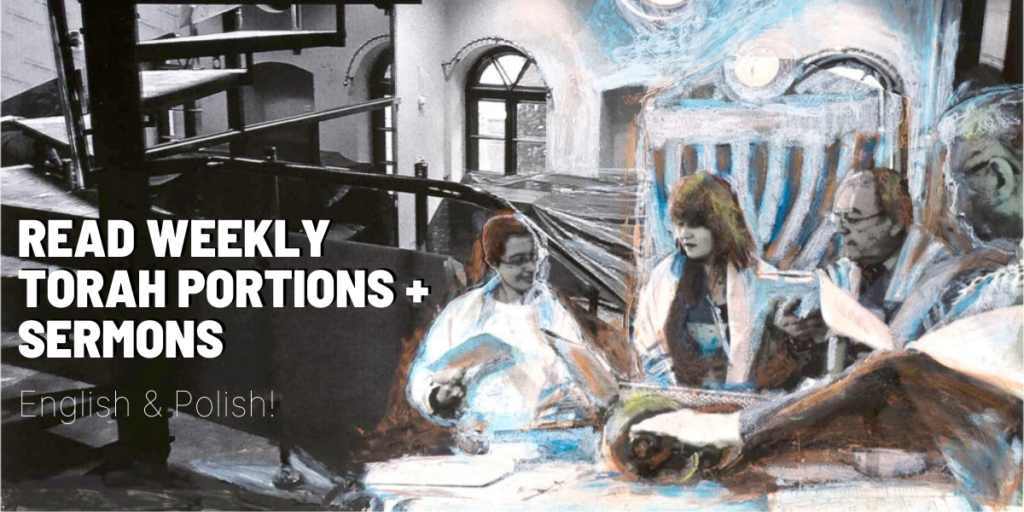13 maja 2016/5 ijar 5776 On the surface, wool and linen don’t seem like that dangerous of a mixture, yet in the midst of this week’s parsha, we are commanded to never blend them: “You shall not let your cattle mate with a different kind; you shall not sow your field with two kinds of seed; and you shall not put on cloth from a mixture of shatnez (Leviticus 19:19). This unique mitzvah is usually considered a hok, a law that defies explanation, and should be followed simply because it was commanded to us. But this did not stop the rabbis from offering up explanations.
Maimonides says that possibly shatnez was worn by priests who were worshiping idols, and that we then should refrain from wearing this profane mixture.
One well known midrash explains that the laws against shatnez are based on the story of Cain and Abel. As we are told in Genesis, Cain brings an offering to God of the “fruits of the soil” and Abel gives an offering of sheep. While we are not told why, God rejects Cain’s offering but accepts Abel’s. This angers Cain and he goes on to murder his brother. The Midrash concludes that “the offering of the sinner should not be mixed with the offering of the innocent”.
Another more mystical explanation from the Sefer Ha Hinuch says that when God was creating the world, every piece of creation, not just humans and animals, but every blade of grass and every piece of life was given a special power and blessing to fulfill a unique mission. When we mix these different parts of creation, even two kinds of fabric, God’s plan is disturbed and thus creation is left broken.
Today this mysterious prohibition is still followed strictly by many, and the search for shatnez has even been helped by the use of technology. Like the laser scanners that check Torahs for mistakes, there are dozens of shatnez labs around the world that use microscopes and other methods to check questionable fabrics for shatnez. As with so many other laws, this strict attention to detail might seem to be going one step too far, yet as with so much else in Jewish tradition, this law does have a higher, and a more understandable purpose.
While most members of the Jewish community are told to not wear these forbidden mixtures, the clothing of the priests are the exception and they may be made of linen and wool. As they serve the highest spiritual needs of the community, the priests are wearing shatnez, and by doing so, they are serving God.
And where else do we receive permission to mix wool and linen? In the tzitzit that we wear on our tallit, where it is permissible to tie wool tzitzit on a linen fabric.
This is a reminder that there are important distinctions in the world. There are holy acts, and there are profane acts, and there are times of spiritual power and times of mundane normalcy. Like the priests, the tzitzit remind us that we should all work to fill our lives, our relationships and our experiences with holiness, as the priests brought holiness to their work. Shatnez is based on the distinctions we experience in life, but we must remember the goal of a spiritual life is to surround ourselves with as much holiness as we can, and to bring this holiness to others. If we can be like the priests helping others mix holiness into daily life, then we are truly serving God.
Dwar Tora Kedoszim
13 maja 2016/5 ijar 5776 Na pierwszy rzut oka nie wydaje się, aby łączenie wełny z lnem mogło być niebezpieczne, a jednak w przeznaczonej na ten tydzień paraszy nakazuje się nam, abyśmy nigdy nie mieszali ze sobą tych dwóch rodzajów włókien: „Nie będziesz twego bydła parzył z odrębnym gatunkiem. Twego pola nie będziesz obsiewał dwojakim gatunkiem ziarna i nie wdziewaj na siebie szaty zrobionej z dwóch rodzajów przędzy (szatnez)” (Kpł 19, 19). Ta niezwykła micwa zaliczana jest zwykle do chukim – do praw, których nie da się wyjaśnić i które powinniśmy wypełniać po prostu dlatego, że tak nam zostało przykazane. Rabini próbowali mimo to znaleźć wyjaśnienie dla tego przykazania.
Majmonides twierdzi, że być może szatnez nosili kapłani, którzy dopuścili się bałwochwalstwa, dlatego też nie powinniśmy nosić tego kojarzącego się z profanacją połączenia.
Pewien znany midrasz wyjaśnia, że prawa zakazujące szatnezu wywodzą się z historii o Kainie i Ablu. Jak czytamy w Księdze Rodzaju, Kain przyniósł Bogu ofiarę „z owoców ziemi”, Abel złożył zaś w ofierze owcę. Nie znamy powodu tej decyzji, Bóg odrzucił jednak ofiarę Kaina, przyjął natomiast ofiarę Abla. Rozgniewało to Kaina, który zabił następnie swojego brata. Midrasz kończy się stwierdzeniem, że „ofiara grzesznika nie powinna być łączona z ofiarą niewinnego”.
Inne, bardziej mistyczne wyjaśnienie pochodzące z Sefer haChinuch głosi natomiast, że gdy Bóg stwarzał świat, każda cząstka stworzenia – nie tylko ludzie i zwierzęta, ale także każde źdźbło trawy i każda inna forma życia – otrzymała specjalną moc i błogosławieństwo, aby spełnić wyjątkową misję. Gdy mieszamy ze sobą różne formy stworzenia, nawet dwa różne rodzaje włókien, zakłócamy tym samym plan Boga, sfera stworzenia staje się zatem niedoskonała.
Wiele osób wciąż ściśle przestrzega tego tajemniczego zakazu, do wykrywania szatnezu korzysta się zaś obecnie nawet z pomocy technologii. Istnieją już skanery laserowe wyszukujące błędów w zwojach Tory; podobnie, na całym świecie istnieje wiele „laboratoriów ds. szatnezu”, w których za pomocą mikroskopów oraz innych metod sprawdza się, czy „podejrzane” tkaniny nie zawierają szatnezu. Przywiązywanie tak dużej wagi do szczegółów może wydawać się nieco przesadzone, zarówno w tej kwestii, jak i w odniesieniu do wielu innych praw żydowskich. Jednakże, podobnie jak w przypadku wielu innych aspektów tradycji żydowskiej, prawo to posiada również pewien wyższy, łatwiejszy do zrozumienia cel.
Większość członków społeczności żydowskiej nie powinna nosić zakazanej mieszanki dwóch włókien, wyjątek stanowią jednak szaty kapłanów, które mogą być wykonane z połączenia lnu i wełny. Kapłani noszą szatnez działając w służbie najwyższych duchowych potrzeb społeczności, służąc w ten sposób Bogu.
W jakiej innej sytuacji pozwala nam się łączyć wełnę i len? W cicit, które nosimy przy naszych talitach – w tym przypadku dozwolone jest dołączenie wełnianych cicit do lnianej tkaniny.
Przypominać ma nam to o tym, że na świecie istnieją ważne rozróżnienia. Są czyny święte, jak również czyny będące profanacją; jest czas przepełniony głęboką duchowością oraz czas zwyczajny, powszedni. Cicit (podobnie jak kapłani) przypominają nam, że wszyscy powinniśmy starać się wypełnić świętością nasze życie, nasze relacje z innymi oraz nasze doświadczenia – tak samo, jak kapłani wypełniali świętością swoją służbę. Zakaz szatnez opiera się na różnicach, których doświadczamy w naszym życiu, musimy jednak pamiętać, że celem duchowego życia jest otoczenie się największą możliwą świętością oraz wnoszenie świętości do życia innych. Jeśli uda nam się postępować niczym kapłani, którzy pomagali innym wpleść świętość do codziennego życia, będziemy wówczas prawdziwie służyć Bogu.
Tłum.: Marzena Szymańska-Błotnicka



















Leave a Reply